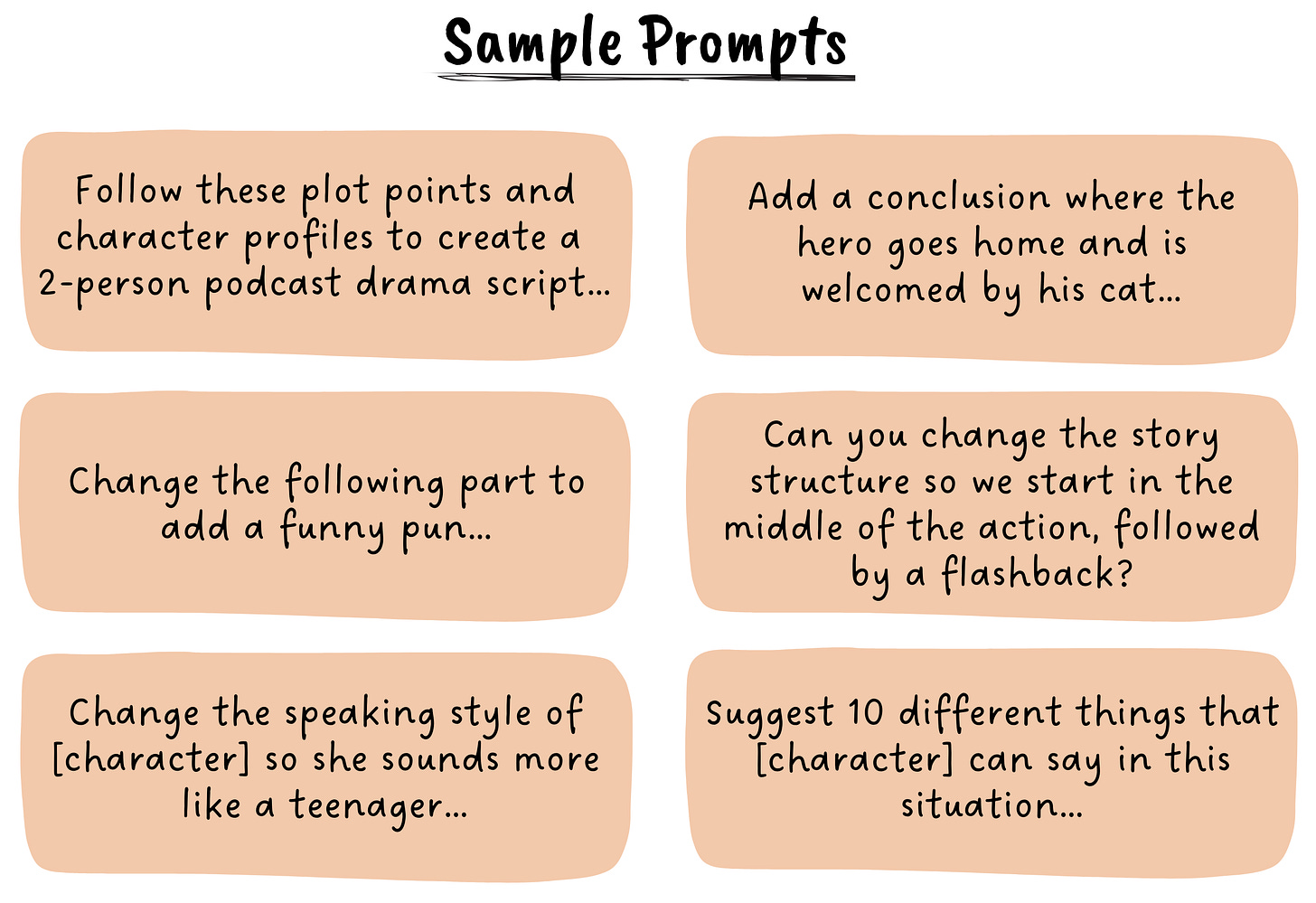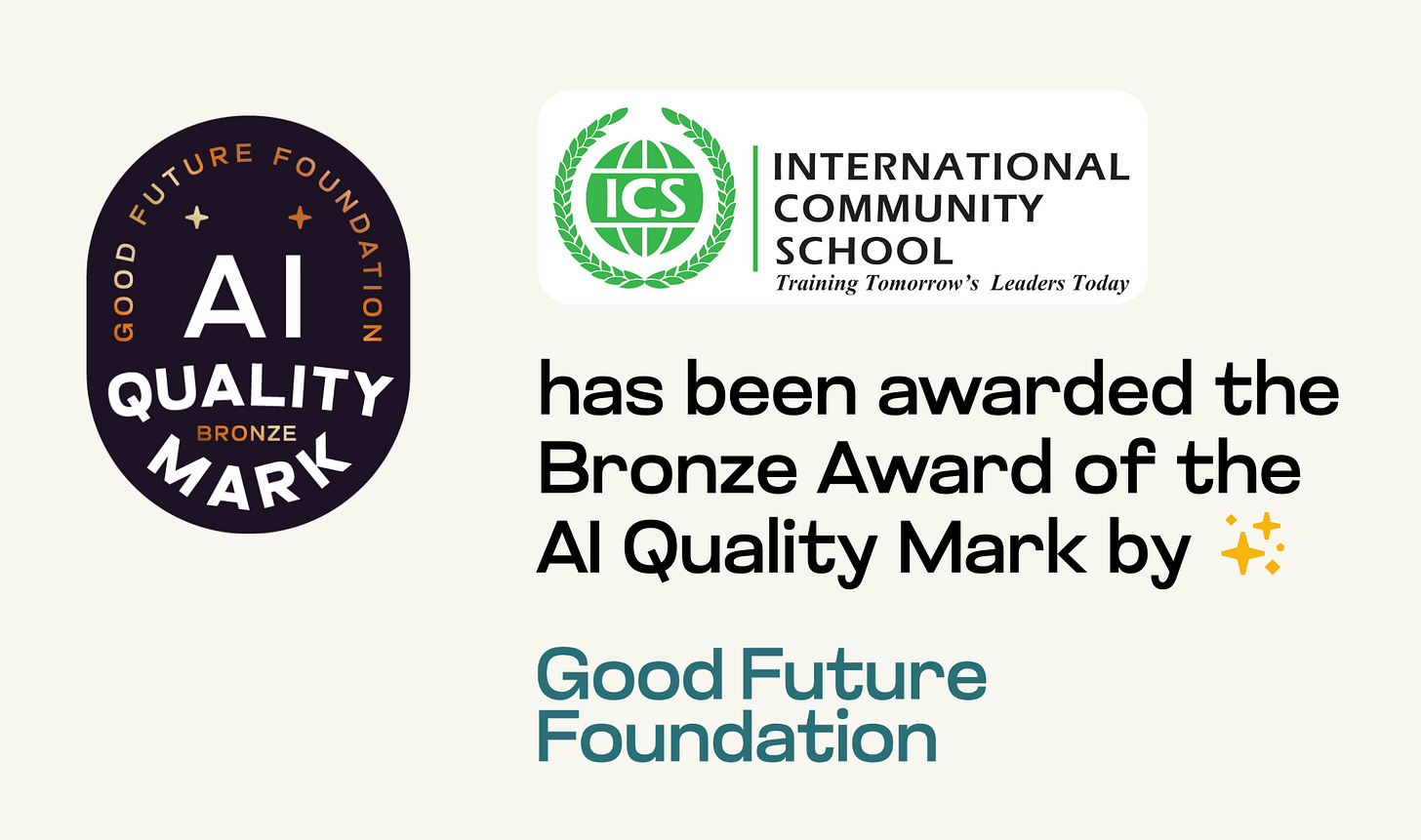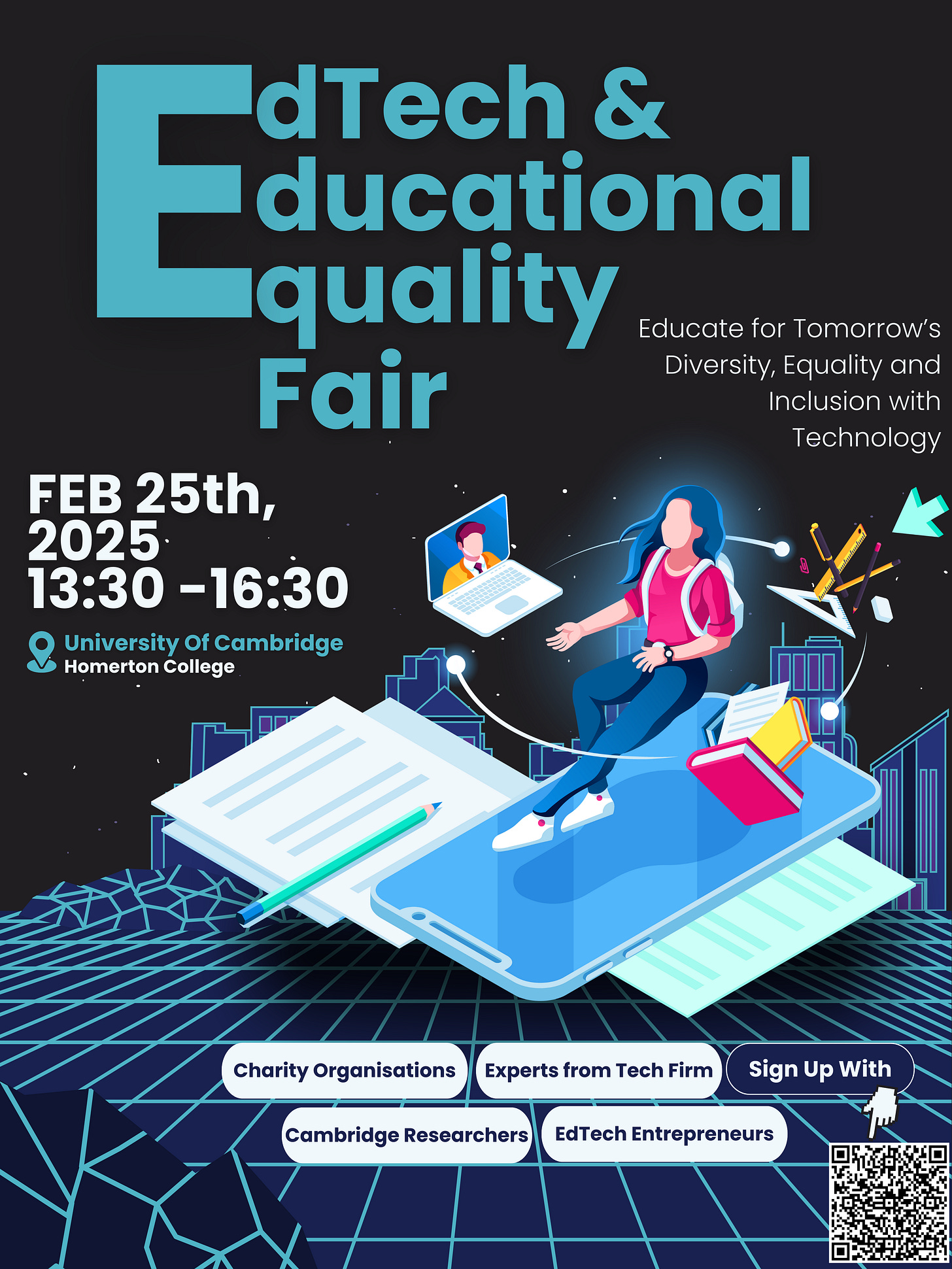January 25' Update
FREE AI Professional Development in Croydon and Stoke-on-Trent in March
Building on the experience of our first AI PD session in Essex last October, we’re partnering with Educate Ventures Research to deliver in-person training in two other locations this March:
Each training session will be tailored to participants' profiles and needs, covering:
AI foundations to enhance your pedagogy
Understanding of AI and media literacy
Approaches to AI safety and ethical implementation
Strategic frameworks based on Prof. Rose Luckin's AI readiness model
Practical evaluation tools to measure AI impact in your context
A friendly reminder that all Good Future Foundation professional development days are completely FREE OF CHARGE, including refreshments! Sign up below to secure your place.
Our 2025 newsletter brings you exciting new content additions. Beyond sharing relevant Foundation updates, we are pleased to welcome Joseph Lin, one of our advisory council members who conducts EdTech experiments and innovative pedagogy research in Hong Kong. He’ll be introducing two new columns that we’re sure you’ll find interesting. The first, AI Big Picture, explores key issues surrounding educational transformation through the lens of AI. The second, AI in Action, offers practical tips and real-life examples of AI deployment in classroom teaching and learning. While Joseph leads these columns, he's eager to feature diverse perspectives from our community. Have a thought to share? Send it our way!
Two Years On, What Have We Learned about AI in Schools?
In short:
AI is here to stay but there’s no consensus on how to live with it (yet)
Early adopters confirm that thoughtful policies, staff upskilling, and honest dialogue about risks and rewards drive lasting impact
Enthusiasm arising from potential productivity boosts needs to be matched by caution about unseen effects on mental health and actual retained knowledge
ChatGPT just turned two at the end of 2024, and we’re seeing the first wave of data about how AI is reshaping work and learning. There’s a lot to be excited about, but news about teen mental health risks, AI-fuelled persuasion/radicalisation, and the risk of reliance on AI remind us to take a measured approach before rolling out untested tools and pedagogies beyond the pilot stage.
In this edition, we focus on three top-of-mind themes that emerged from discussions with educators in Hong Kong and Singapore, in the hopes of attracting broader perspectives from around the world.
Your thoughts are welcome at info@goodfuture.foundation.
1. Plagiarism & Academic Honesty
“My student’s grammar suddenly became flawless and their ideas actually make sense now, of course it’s AI.”
“I can’t assign take-home work anymore, we’re back to in-class assessments and exams.”
“I watched a YouTube tutorial about giving the AI my old homework so it can write like me.”
Perspective: It seems obvious in hindsight that Large Language Models would impact fields that rely heavily on language, like education. It’s also obvious that current norms around assessment will have to change, especially at the secondary and tertiary levels.
Teachers must know that AI writing detection does not work, and many universities have disabled the detection function in Turnitin (e.g., Yale, MIT, Berkeley, Vanderbilt, SMU, etc.).
The prognosis doesn’t have to be grim, teachers will find better ways to assess student performance—consider how calculators changed the way Maths is taught.
2. Staff Burnout
“The whole staff room is exhausted and if AI can save them a few hours a week, that’s great.”
“All the time I spent writing reports should’ve been spent on students.”
“I know I could’ve done more, but who has the time?”
Perspective: The good news is that AI productivity gains are real. Microsoft Research found that knowledge workers can save at least 30 mins a day using AI, and AI users also produce 10% more documents than before while spending up to 25% less time on emails (yes please!). Anyone who has tried any state-of-the-art model will know how AIs can blitz through lesson materials and reports; tools and workflows just need to be discovered first.
Because schools generate so much paperwork, the hardest part of implementing AI (documenting processes, keeping reports and minutes, digitising homework, etc.) is already half done. The challenge currently lies in the last mile, where tools don’t yet exist to help schools tie together all their information while making that accessible in a user-friendly way, but I have no doubt that learning management systems companies are all working on that.
3. Supporting Students
“Asking AI a question is less stressful than sending an email to my teacher. And I can get answers at 3AM.” (Ed: even though this is possible, we should prioritise sleep health and 'switching off' above all else)
“Their homework is better with AI, but how do I know if it reflects their comprehension or the AI’s?”
“How can we let students use all these AI tools when even the teachers don’t know anything about them?”
Perspective: All signs point to new and better forms of student support. A working paper from Nigeria shows that students who had never used a computer before achieved 2 years’ worth of learning gains in 6 weeks, by going to a computer lab twice a week to use GPT-4 as a tutor. However, a Wharton paper also showed that if you take the AI away, students can actually perform worse than those who didn’t use AI in the first place.
Regardless, earlier findings about how AI can help some entrepreneurs make more money, researchers make more discoveries, artists create more popular art will probably be echoed in education, as future research reveals all the ways that AI can make teachers and students more effective.
What’s Next?
If the history of the Internet and smartphones taught us anything, it’s that AI will remain a buzzword for about a decade. At some point, shiny new technologies will be taken for granted and we will just think, “of course I can generate 30 sets of assessments and worksheets and notes tailored to each student’s needs and interests. I just need to hit enter!”
AI Loves Creative Writing
Lessons Learned:
Creative writing lessons turn AI hallucinations into an advantage
Design tasks that encourage editing and iteration
Image and music AIs are highly effective at engaging students
Effective prompting makes personalised learning a doodle
The fact that AIs can hallucinate and generate false content has been drummed into anyone who’s been paying attention since ChatGPT launched in 2023. It can be a serious issue in many use cases, but in creative writing lessons, a bit of randomness just makes for a more serendipitous story.
While AI labs are still trying to fix hallucinations by teaching models to reason (like OpenAI’s o1 family) and by grounding them in data (Anthropic’s Model Context Protocol comes to mind), here’s how a pilot lesson with Primary 5 to 6 students at the Hong Kong Academy for Gifted Education used AI to support ESL students:
Lesson Plan
Planning on Pen and Paper
In this 12-hour course, students wrote a short story, converted it into a podcast drama script, recorded themselves performing the story, and generated images and audio accompaniment.To mitigate students outsourcing their thinking to AI, they began by creating character profiles and outlining the plot on pen and paper.
Edit and Expand with AI
Students typed their handwritten notes to form a prompt for the AI (we used GPT-4o). It was a deliberate choice to keep planning on pen and paper, because the data entry gives students an opportunity to edit and iterate their work as they type.We also covered basic prompt engineering and AI literacy, emphasising cautionary tales like the New York lawyers whose AI-generated work had inaccuracies.
Students were taught to discuss and edit the story with the AI (e.g. “How can I make this part funnier?”) and given time to finalise a ~3-minute script fit for as many members as they have in their group (as a former language arts teacher, this is such a godsend).
Generate Images and Soundtrack
Each group reads their script aloud and each member gets to choose their favourite moment in the story. That is the moment they’ll use AI to generate, and students have to write image-generation prompts to get the look and style they want (Canva’s free K–12 plan works well, while paid options like Midjourney would give fancier results).




Example images generated Similarly, students used music generators like Suno and Udio to generate a theme song for their story—asking GPT-4o to analyse the script to form a prompt for the songwriting AI. Generating images and music was highly entertaining to the students, and also helped them practice vocabulary related to imagery.
Record and Present
While students can easily generate AI voices performing their script, that doesn’t help them practise speaking English. Therefore, students used an AI voice changer (we used Elevenlabs) to transform their own performance into different voices while preserving their intonation and cadence.Example of student’s work:
In the end, all the generated media were combined into a slideshow. Everyone listened to everyone else’s stories, everyone clapped, and the lesson was done!
In the next edition…
An Intro to Psych course at a community college uploaded their textbook and outlines to an AI chatbot, so students could ask questions 24/7, in any language they want, following the same terminologies and framework they learned in lectures.
Send us your AI in Action questions, use cases, and ideas at info@goodfuture.foundation!
Exciting Updates on the AI Quality Mark!
Congratulations to ICS Ghana - the First non-UK School Completing The AI Quality Mark
We’re celebrating ICS Ghana’s tremendous efforts and commitment in exploring AI integration to support their teachers and students - especially impressive given their challenges with limited internet and device access!
Although our self-assessment framework was initially developed for UK schools, it reflects principles that speak to every educator and every school. We welcome educators worldwide who are seeking a solid framework to guide your AI integration efforts.
Understanding the Self-Assessment Approach
Dr. Andy Kemp, our framework architect and Advisory Council member, recently shared insights on SecEd about our unique self-assessment process. His article explains how schools benefit from this collaborative approach, which combines self-evaluation with constructive moderation support. Click below to learn more about the accreditation journey.
Growing Interests and Commitments
While over forty schools and multi-academy trusts have explored the AI Quality Mark. we’re delighted to welcome five schools who have taken the next step and committed to the framework:
St John the Baptist School
King Edward VI Aston School
King's School Rochester
Oakmoor School
Colchester Royal Grammar School
Want to Learn More First?
Join our upcoming session with the CAS AI Community to discover the framework's benefits and hear from schools using it. Register here.
Ready to Start Your Journey?
Sign up below to explore how the framework can support your school's AI integration. We'll contact you shortly after receiving your registration.
Building AI Literacy in Classroom with Big Education
We couldn’t be more excited about about our significant partnership with Big Education, a Multi-Academy Trust and a charity working towards a balanced education of the head, heart and hand.
In this partnership, we will be contributing research, content, and training as Big Education is working on building school leaders and teachers capacity to provide students with critical AI literacy skills. We will also be celebrating and showcasing successful AI implementation in schools together.
Big Education is now collecting views on AI from school leaders, teachers, parents and students. By taking a few moments to share your thoughts, you’ll directly contribute to:
• A framework of principles for effective AI use
• An online workshop for school leaders
• A programme of AI CPD for teachers
• An AI literacy curriculum for students
These resources will be shared nationally, and your input will be crucial in ensuring they meet the real needs of our educational community. Please visit the below for more information.
Coming Together for Educational Equality
Open dialogue and diverse perspectives help us better understand and address the challenges in educational technology and equity. We’re delighted to join the EdTech and Educational Equality Fair on 25 Feb at the University of Cambridge, organised by the Cambridge Homerton Educational Technology Society.
The event will showcase innovative EdTech strategies and practical solutions that promote educational equality, while fostering networking opportunities for the Cambridge community. Our Executive Director Daniel Emmerson will contribute to discussions with fellow speakers including the AWS Global Education Equity Leader, Founder of ZNotes, EdTechX Award Winner and President of Faculty of Education Research Student Association.
Join the conversation at this student-led initiative. View details and register here.
Foundational Impact Podcast: Insights from Richard Culatta and Laura Knight
Our podcast kicks off the new year with two pioneering voices in education technology. Richard Culatta, CEO of ISTE and ASCD, draws on flying planes as an analogy to illuminate the risks of taking a haphazard approach to AI in education. Laura Knight, a linguist turned digital strategy consultant, offers an encouraging perspective for non-tech savvy educators on asking the right questions about implementation, data and student privacy.
Both guests share their passion for helping educators navigate AI in education. Give these episodes a listen for practical recommendations and insightful advice!





















